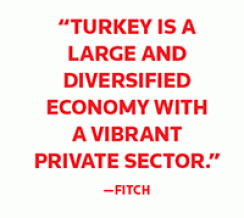To view a PDF of the report, click here.
Despite current challenges, long-term ambitions still in place
Viewed through a short-term lens, the immediate prospects for Turkey’s economy look bleak. Following a period of breathless expansion in the five years to 2015, during which GDP growth averaged 7.1 percent, growth slowed to 6.1 percent in 2015 and to 2.1 percent last year, according to the World Bank.
The Turkish lira, meanwhile, lost 18 percent of its value in the three months to January 2017, exerting upward pressure on inflation. Consumer prices rose by 8.5 percent in 2016, well above the central bank’s 5 percent target.
The downturn in the economy and heightened political risk have been reflected in the negative trajectory of Turkey’s rating. In January, Fitch joined the other leading ratings agencies when it pushed Turkey into sub-investment grade. “Political and security developments have undermined economic performance and institutional independence,” Fitch explained when it notched Turkey’s Long-Term Foreign Currency Issuer Default Rating (IDR) from BBB- to BB+. High-profile terrorism attacks, meanwhile, have damaged consumer confidence and the tourism sector, Fitch noted.
Investors keep faith
Investors, however, have continued to show faith in Turkey’s long-term potential—albeit at an elevated price. When the government launched a $2 billion 10-year benchmark in January at an attractive 6 percent coupon, it generated demand of close to $7 billion. There was a similarly encouraging response among investors when Turkey reopened the issue for another $1 billion in February, building an order book of $4.7 billion for the deal, priced at 5.65 percent.
Fixed income investors’ continued support for Turkey is a reflection of their continued pursuit of elusive opportunities for enhanced returns in a global low-yield environment. But it may also reflect their confidence in Turkey’s much longer-range economic and social potential. The most ambitious targets for this longer-term development are those enshrined in the government’s Agenda 2023 program, a self-assured blueprint for economic growth, improvement of living standards and an upgrade in infrastructure as the Turkish Republic approaches its centenary.
This aims to position Turkey among the world’s 10 largest economies (up from an estimated 18th in 2016) by doubling GDP from around $1 trillion in 2015 to a little over $2 trillion in 2023, increasing GDP per capita from $14,000 to $25,000. Over the same period, exports are projected to rise from $200 billion to $500 billion, with unemployment dropping to 5 percent and inflation and interest rates settling in single digits.

It is probable that many of the more ambitious objectives for 2023 will need to be watered down to reflect the increasingly precarious nature of geopolitics in the region. Take the example of Agenda 2023’s targets for the tourism industry, based on 50 million visitors generating annual revenues of $50 billion. In 2016, foreign tourist arrivals plunged by 30 percent to just over 25 million. Although tourism is expected to recover as relations between Russia and Turkey normalize, last year’s downturn in the industry has had a profound impact on economic growth and job creation. The IMF estimates that a 10 percent fall in tourism arrivals translates into a contraction in GDP of 0.3–0.5 percent.
More broadly, however, economists say they are skeptical about the chances of Agenda 2023 delivering on its promises. “The problem with Erdogan’s ambitions of transforming Turkey into an Asian-style tiger economy is that Asia’s success has been built on a high savings and investment rate,” says Jan Dehn, Head of Research at the London-based emerging market specialist, Ashmore. “By contrast, Turkey has an abysmal savings rate and a permanent current account deficit funded by portfolio flows that are notoriously unreliable.”
Continued growth potential in banking sector
The good news is that even if Turkey falls short of the goals set out in Agenda 2023, its growth potential over the coming decade will provide opportunities for investors across a wide range of industries, underpinned by a growing population, favorable demographics and an entrepreneurial culture. “Turkey is a large and diversified economy with a vibrant private sector,” notes Fitch, adding that Human Development and Doing Business indicators, as measured by the World Bank, are stronger than in many comparably-rated countries.
Financial services is a likely beneficiary of Turkey’s demographic profile. As Akbank highlights in its most recent investor presentation, 50 percent of the population is under the age of 49, and some 48 million Turkish citizens are categorized as “unbanked” or “semi-banked.”
According to the Akbank numbers, loans and deposits in the Turkish banking system are a modest 65 percent and 54 percent of GDP respectively. Household debt to GDP, meanwhile, is 17 percent, compared with well over 100 percent in developed economies such as Australia.
The potential suggested by this under-penetration of banking services has been reflected in the recent performance of some of the country’s leading banks, which posted encouraging growth even against the backdrop of an uncertain economic and political backdrop. Equally encouraging was the banks’ continued support for smaller borrowers. Halkbank, for example, reported growth of almost 27 percent in total commercial loans in 2016, with one in three Turkish SMEs reportedly supported by the bank last year. “We are again at the top of the SME segment with craftsmen and artisans, the backbone of the Turkish economy,” said General Manager, Ali Fuat Taşkesenlioğlu, when Halkbank announced its 2016 results in February.
The growth potential implied by the under-development of banking services in Turkey is also reflected in the forecasts for continued expansion at Akbank. Based on projected annual economic growth of 3–3.5 percent, Akbank expects to post compound annual growth rates (CAGR) of 11–13 percent in loans and deposits between 2017 and 2019.
As with the broader outlook for the economy, the short-term prospects for Turkey’s banking industry remain challenging. In its most recent review, Standard & Poor’s (S&P) cautions that the weakness of the Turkish lira versus the dollar will increase the pressure on the banks’ asset quality. As a result, S&P is expecting non-performing loans (NPLs) to reach 5 percent of total gross loans this year, sharply up from 3.3 percent at the end of 2016. Moody’s is more sanguine, forecasting a 4 percent NPL rate at the end of 2017, but warning that this will require increased provisioning expenses and lead to reduced profitability.
Over the longer term, however, the Turkish banking industry looks well-positioned to weather the political and economic turbulence casting a shadow over its performance today. As S&P observed in February, “we believe that Turkish banks have adequate asset quality, sufficient earnings, and good capitalization, such that they can absorb potential moderate volatility without damaging their financial profiles unduly.”





